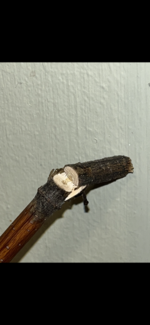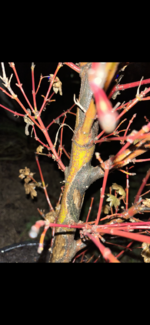JmoneyJonathan
Seed
Hi all,
I purchased a large clearance section Acer Circinatum "Little Gem" today from a local landscaping nursery, and I'm hoping somebody can help me identify its sickness and whether it should be tossed or salvaged. The tree has large sections of dieback which I assumed to be a result of drought; however, upon closer inspection, I see several things that lead me to believe the cause is far more sinister, possibly verticillium wilt. Most branches have died from the tips; a significant portion of the tree has died back completely (2 of 3 trunks); the base and several veins of the live trunk are blackened; and the heartwood displays what seems to be the characteristic discoloration that we expect for verticillium. The trunk base also had white spots on the surface (circled in red), not to be confused with the wood shavings scattered from the saw.






However, a look at some afflicted branches' cross sections gives me hope that verticillium is not the culprit. To my eye, these samples exhibit both dieback and blackening of live tissues, but they do not exhibit the dark rings in their heartwood. I supposed it's possible that the lower section is in fact infected, while the top sections that I sampled have dieback from a separate environmental condition.




Please let me know what you all think. While I would love to see this tree thrive, I will burn it by the end of the week if it has verticillium. If it something else is the issue, is it possible to save? Thank you in advance for your time and expertise.
Best,
Jon
P.S. I apologize for my first post being "help me with this disease." I searched other threads, but I did not come to a satisfying diagnosis for this tree. I have some interesting projects that I will share one of these days.
I purchased a large clearance section Acer Circinatum "Little Gem" today from a local landscaping nursery, and I'm hoping somebody can help me identify its sickness and whether it should be tossed or salvaged. The tree has large sections of dieback which I assumed to be a result of drought; however, upon closer inspection, I see several things that lead me to believe the cause is far more sinister, possibly verticillium wilt. Most branches have died from the tips; a significant portion of the tree has died back completely (2 of 3 trunks); the base and several veins of the live trunk are blackened; and the heartwood displays what seems to be the characteristic discoloration that we expect for verticillium. The trunk base also had white spots on the surface (circled in red), not to be confused with the wood shavings scattered from the saw.






However, a look at some afflicted branches' cross sections gives me hope that verticillium is not the culprit. To my eye, these samples exhibit both dieback and blackening of live tissues, but they do not exhibit the dark rings in their heartwood. I supposed it's possible that the lower section is in fact infected, while the top sections that I sampled have dieback from a separate environmental condition.




Please let me know what you all think. While I would love to see this tree thrive, I will burn it by the end of the week if it has verticillium. If it something else is the issue, is it possible to save? Thank you in advance for your time and expertise.
Best,
Jon
P.S. I apologize for my first post being "help me with this disease." I searched other threads, but I did not come to a satisfying diagnosis for this tree. I have some interesting projects that I will share one of these days.


